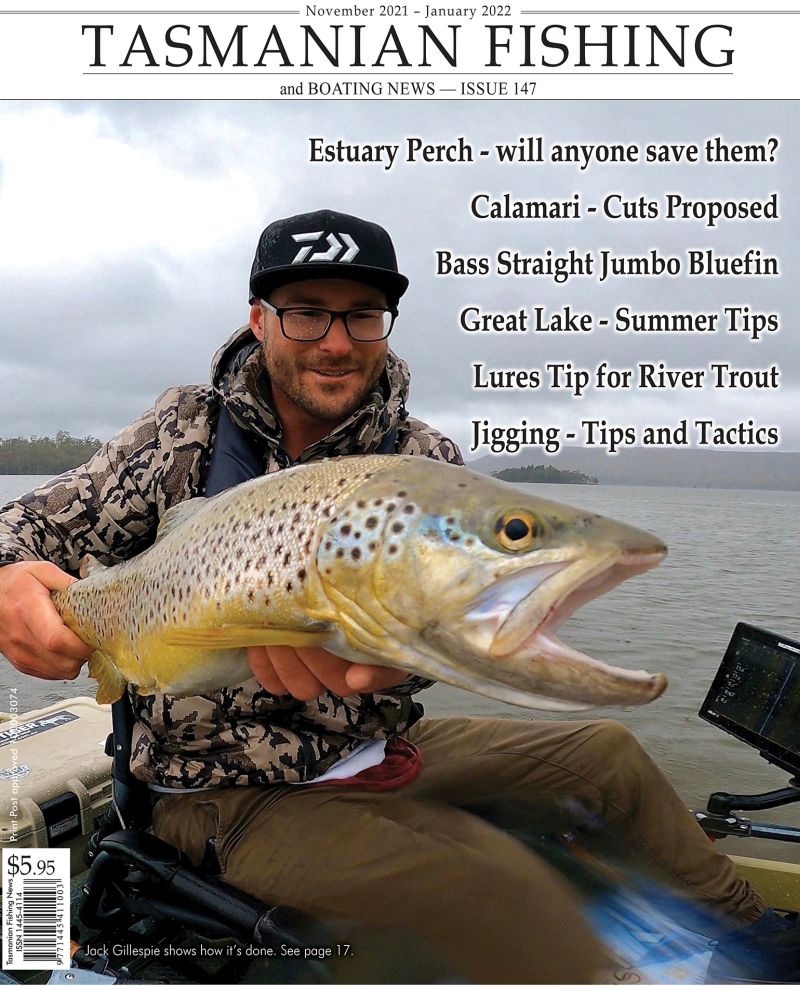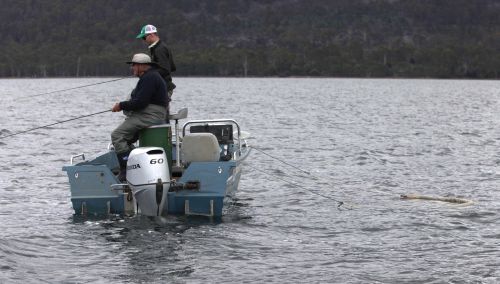From the Archives ...
"Angling is an art - Hannah Ledger
and an art worth your learning.."
Presented from Issue 112, October 2014
So said Izaak Walton in the 1600s. It seems that Burnie’s Hannah Ledger has combined angling with art rather well. Hannah is a fish fanatic, outdoor enthusiast and budding, self-taught artist. From as young as she can remember, she has always had crayon in hand, colouring book under arm and as she’s grown as a painter, jars full of paintbrushes and cupboards full of ready-to-go blank canvas’.
A country girl at heart, Hannah was schooled at Yolla District High School, a small ‘farm’ school in the states North West, then went on to Hellyer College where she was given the opportunity to really grow her art skills; And by grow, that meant skipping the classes that would probably have more an impact of getting her somewhere in life, like English and Math to spend every spare minute with the art teacher, painting or drawing.
As typical teenagers do, they make poor decisions- and after being accepted in to one of the countries top art schools, turned down the offer and decided to move to the big island, where she lived for 5 years working in what seemed ‘dead end’ retail.
Read more ...Please check all relevant authorities before fishing - www.ifs.tas.gov.au and dpipwe.tas.gov.au . Don't forget issuu.com/stevenspublishing for years of back issues !
Mako Madness
by Scott Baker
It's early February, and with the water temperature starting to rise, and the appearance of the small pelagic tuna off the north east coast. Wade Pelham and myself decided it would be a good time to seek out a highly regarded game fish; the Blue Pointer or more commonly known as the Mako.
- Category: Saltwater and Estuary Fishing
- Hits: 8876
Hart's Hints - Little things can make a difference
by Andrew Hart
Fish can often be very frustrating. Many people find themselves going fishing for an afternoon of relaxation, and end up getting all uptight because of some little, annoying thing that could have been avoided.
There are many simple, innovative ideas that can make the wonderful world of fishing a whole lot easier. Some of these ideas are available at your local tackle shop, others can be put into practice around the house.
In this, the first article of a series, listed are some useful tips, techniques and accessories that make a huge difference.
- Category: Tackle, Boats and other Equipment
- Hits: 5527
Read more: Harts Hints. Little things can make a difference.
Do we underestimate our Redfin Perch
The Redfin as it is known to most Tasmanians is not favoured by many anglers - although there is no reason why this should be so. The Redfin will take flies, lures and bait readily and is quite good to eat. A lot of anglers consider it a nuisance good ENGLISH PERCH (Redfin-Perca fluviatilis) According to a Royal Commission report on the fisheries of Tasmania issued in 1882-3, the English Perch was first introduced to Tasmania in 1862 by two brothers, Morton and Curzon Allport.
- Category: Other Lakes
- Hits: 16315
Derwent River trout an early treat
Steve Bax from Hobart's Fishing Connection previews fishing for sea run trout in the Derwent River.
Some of the best trout fishing in Tasmania is found on Hobart's doorstep in the Derwent River. At this time of the year most anglers catch their fish on bait - using the local pretty fish, but there is also dedicated band of fly fishers. The pretty fish are found all over the Derwent, as are the trout.
- Category: Derwent River
- Hits: 8721
Cooking Tamar River Cod
by Steve Suitor
Two of the most prevalent species present in the Tamar are Flathead and Cod.
Flathead has a firm white flesh which is excellent fare whether it be fried, grilled,BBQ or soused. While most cooks have little trouble presenting flathead in an attractive and appetising manner, a great many have trouble with cod.
- Category: Cooking Fish
- Hits: 10017
Lures and flies for August and September
by Michael Stevens
Recently I surveyed a number of well known, and some not so well known anglers to establish a guide to lures and flies for the start of the trout fishing season. Firstly lures, and then flies that the following anglers would like to have in their box for the opening two months. Each angler was asked "If you could only have three lures/three flies in your box for the start of the season, what would they be? "
- Category: Tackle, Boats and other Equipment
- Hits: 12198
Redmap Newsletter Signup

Join up to Redmap between now and 31 March 2011 and you’ll go in the draw to win a $400 voucher to spend on fishing gear, dive and snorkelling equipment OR marine gear. Visit http://www.redmap.org.au/news/posts/view/65/win-a-400-voucher/ for more details.
- Category: IFS, DPIPWE, MAST and Peak Bodies
- Hits: 5460
Subcategories
Current TFBN
Click above for current issue content. The current issue of TFBN is extensive and topical. In Tackle Stores, Newsagents and by subscription.
Delivered to your door for $48 for 2 years (8 issues). To subscribe, send Mike $48 via www.paypal.com.au . (Basic instructions are here) The email is at Contact Us. Your address will be included from PayPal.
Or phone Mike with your c/c handy on 0418129949
Please ensure your details are correct, for Mike to organise delivery.
TFBN Newsletter Sign up Form
Why not submit an article ?
When you have finished for the day, why not have a brag about the ones that didn't get away! Send Mike an article on your fishing (Click here for contact details), and we'll get it published here. Have fun fishing - tasfish.com
Category Descriptions
Here is a list of all of the Article Categories. The number in Brackets, eg (13) is the number of articles. Click on Derwent River and all articles relating to the Derwent will be displayed in the central area.
Articles by Category
-
Rivers (3)
-
Saltwater and Estuary Fishing (149)
-
Kayak Fishing (34)
-
Lakes (1)
-
Great Lake (62)
-
Lake Leake (52)
-
Woods Lake (16)
-
Lake Augusta (11)
-
Huntsman Lake (13)
-
Lake Pedder and Gordon (10)
-
Lake Dulverton (5)
-
Lake Crescent (6)
-
Tooms Lake (10)
-
Lake Mackintosh (2)
-
Lake Barrington (5)
-
Little Lake (8)
-
Meadowbank Lake (5)
-
Lake King William (7)
-
Lake St Clair (2)
-
Western Lakes (12)
-
Arthurs Lake (35)
-
Lake Echo (7)
-
Four Springs (54)
-
Lake Sorell (7)
-
Lake Burbury (6)
-
Other Lakes (57)
-
Brushy Lagoon (18)
-
Little Pine Lagoon (5)
-
Penstock Lagoon (16)
-
Brumbys Creek (7)
-
-
Events (48)
-
Estuary Fishing (0)
-
Coastal Catches (46)
-
Super Trawler (46)
-
IFS, DPIPWE, MAST and Peak Bodies (435)
-
Commercial Interests (98)
-
Other (24)
-
TFBN Back Issues (8)
-
Fly Fishing (67)
-
Trout Fishing (250)
-
Meteorology and Weather (8)
-
Jan’s Flies (50)
-
Tuna Fishing and other Game Fishing (86)
-
Cooking Fish (19)
-
Fishing Information (1)
-
Fishing Books (8)
-
Videos (5)
-
Tackle, Boats and other Equipment (146)
-
World Fly Fishing Championship 2019 (2)
Popular Tags
windyty.com
Visit https://www.windyty.com/
Rubicon Web and Technology Training
Hello everyone, I thought it would be a good time to introduce myself.
My name is Stephen Smith and I have been managing the website tasfish.com since May 2009.
It has been an epic journey of learning and discovery and I am indebted to Mike Stevens for his help, support and patience.
I am developing a new venture Rubicon Web and Technology Training ( www.rwtt.com.au ). The focus is two part, to develop websites for individuals and small business and to train people to effectively use technology in their everyday lives.
Please contact me via www.rwtt.com.au/contact-me/ for further information - Stephen Smith.
From the Archives ... (last chance)
Suggestions for Early Season Waters
Suggestions for Early Season Waters
by Sarah Graham
Many anglers are preparing for the opening of the new angling season on Saturday 7 August and it's shaping up to be another good one with the fishery in excellent health as a result of last year’s drought breaking rains. There are many great fishing locations around the State from which to choose for the opening weekend and early season fishing but here are a few suggestions.



